The 9 Best Mountain Towns to See Fall Foliage
This article originally appeared on Outside
Nothing beats a mountain slope ablaze with fall color. I know there's a scientific explanation for the phenomenon--chlorophyll production stops, carotenoids take over--but I believe the leaf transformation is Mother Nature's greatest magic trick, when she turns a canvas of green into sparkling hues of red, orange, and yellow.
Living in North Carolina's Blue Ridge mountains, I am a lifelong leaf watcher, and have found nine mountain towns that are smack dab in the middle of the magic. Each gives you easy access to scenery and adventures, but also offers good food, comfortable digs, and a chance to make the most out of the season--think brisk fall hikes, pumping bike rides, and Oktoberfests.
1. Blowing Rock, North Carolina
Named after a cliff overlooking a gorge where wind seems to blow upward, the small, tourist-centric town of Blowing Rock is sandwiched within the lush slopes of the Southern Appalachians, which are incredibly green in the summer but come alive with color in fall as the hardwoods show off in reds, oranges, and yellows. The small town has a walkable, quaint village vibe, but is surrounded by some of the most rugged peaks in the East.
Peak Season: Blowing Rock sits at around 4,000 feet, and fall color tends to peak in mid to late October here, although you'll still find color in early November. Sugar Mountain Ski Resort hosts an Oktoberfest the weekend of October 7 to 8, and the annual Woolly Warm Festival, which has a caterpillar race that prophesies the length of winter, runs October 21 and 22.
What to do in Blowing Rock
Cruise the Blue Ridge Parkway: Running for 469 miles between Virginia's Shenandoah National Park and the Great Smoky Mountains National Park in North Carolina, the Blue Ridge Parkway is a bucket-list destination for a scenic drive or epic mountain pedal. I think one of the prettiest sections of the two-lane paved road is near Blowing Rock. Whether you're pedaling or driving, plan to traverse the Linn Cove Viaduct, a 1,234-foot- bridge that hovers along the edge of Grandfather Mountain, delivering epic long-range views. From Blowing Rock, make a 20-mile loop by heading south on the Blue Ridge Parkway for 10 miles, crossing the viaduct, and taking Highway 221 north back to town.
Hike Grandfather Mountain: The five-mile out-and-back journey on Grandfather Trail is a mix of hiking, rock scrambling, and ladder climbing as you make your way up and over three distinct 5,000-foot peaks along the mountain. It's a vertical adventure and one of my favorite trails in the South. In just over two miles gaining 1,500 feet, you'll get unmatched views of the surrounding 5,000- and 6,000-foot peaks of North Carolina's High Country.
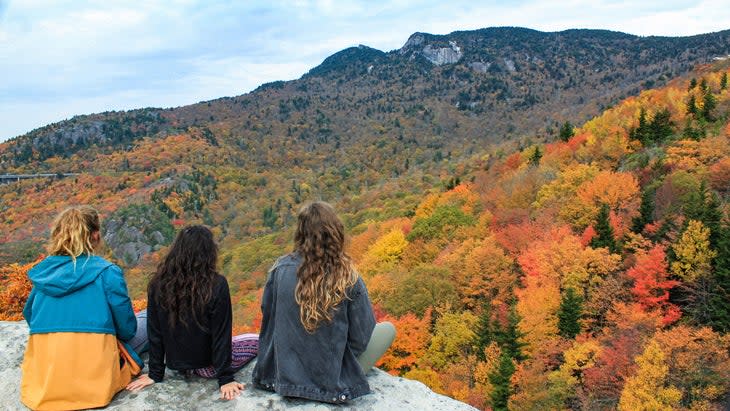
Stay: Treat yourself with a room and some hands-on relaxation at Westglow, a resort and spa operating out of a historic Greek Revival mansion on a 42-acre mountain top outside of Blowing Rock. (From $250 a night, with a three-night minimum during leaf season.)
Don't Miss: The southern fair at The Speckled Trout, a casual restaurant and bottle shop on Blowing Rock's Main Street that focuses on home-grown ingredients. Try the Cilantro Trout Nachos.
2. Salt Lake City, Utah
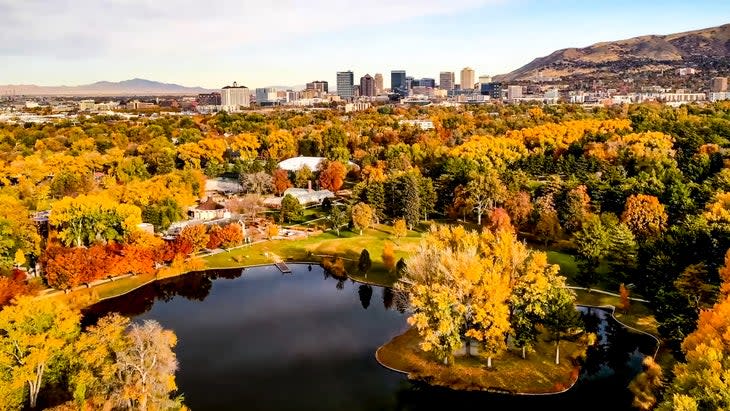
OK, Salt Lake is a city (population 200,478), but it's a mountain city, with access to eight canyons dropping off the adjacent Wasatch Mountains and loaded with white-trunked aspens with leaves that turn bright yellow during fall. The leaf peeping begins right in the heart of town, where parks hold stands of old-growth trees, but you want to spend most of your time exploring the tree-lined gorges that descend from the mountains east of the valley.
Peak Season: Hit it from mid-September through mid-October to see the aspens pop. Snowbird Resort hosts an ongoing Oktoberfest celebration, complete with lederhosen and beer steins, every weekend from August 12 to October 15. You can also try to catch a football game at the University of Utah's Rice Eccles Stadium.
What to do Around Salt Lake City
Pedal Big Cottonwood Canyon: The 15-mile-long State Road 190 climbs through the heart of Big Cottonwood Canyon, ascending almost 4,000 feet from Salt Lake to Brighton Ski Resort. It's a popular scenic drive in the fall when the aspens are popping, but also a badass road-cycling route with plenty of long-range views and rest stops at picnic areas. You'll contend with some 13 percent climbs, but remember this is an out-and-back, so anything you climb, you get to bomb, including the dramatic "S Curve" switchback in the middle of the route. Keep an eye out for moose.
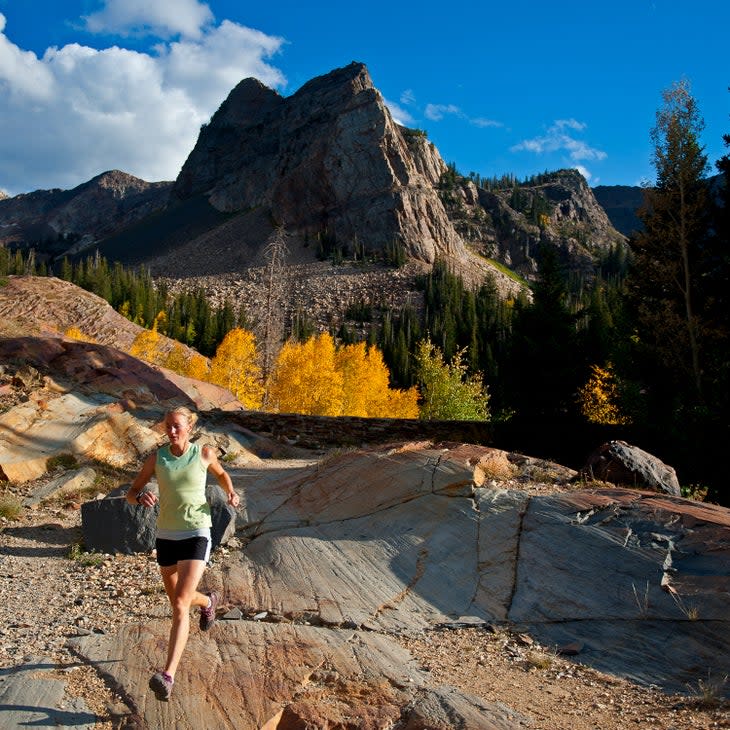
Run the Wasatch Crest Trail: This high-alpine singletrack has near-constant 360-degree views as it rolls between 7,000 and 10,000 feet from Big Cottonwood Canyon all the way to Park City. It's one of the most popular mountain-bike trails in Utah, but tackling it as a trail run might give you more opportunity to soak in the big views. You can form a loop from the top of Millcreek Canyon via the Big Water Trail, Desolation Lake Trail, Wasatch Crest, and Red Pine Trail that will take you through a number of aspen groves before and after topping out on the Crest.
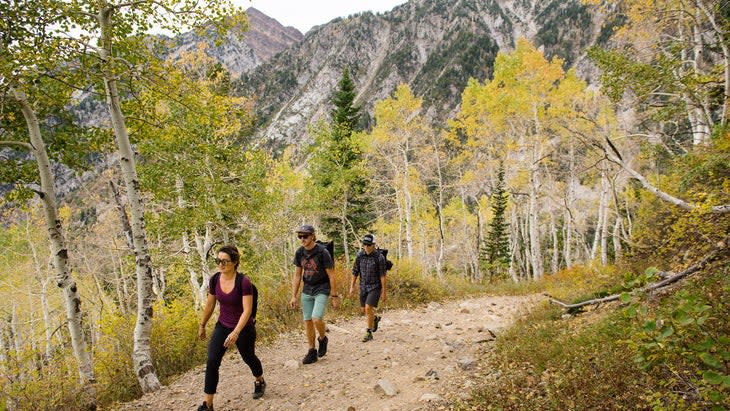
Stay: The evo Hotel, in the Granary District, a now thriving former industrial zone, doesn't just have comfy rooms but a bouldering gym, yoga classes, and regular film nights. From $163 a night.
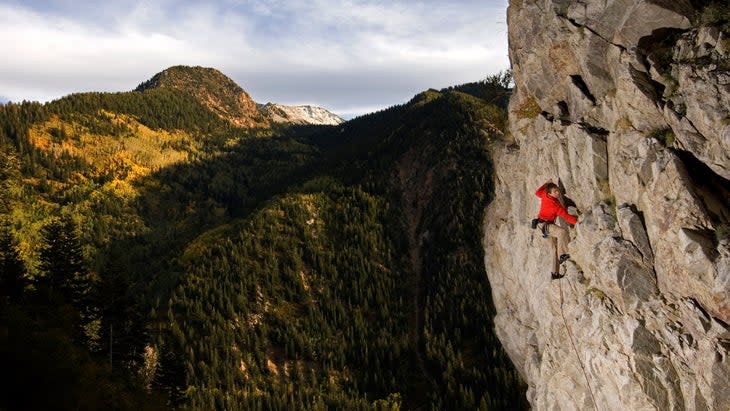
Don't Miss: TF Brewing is also located in the Granary District, and specializes in lagers perfect for drinking on a crisp fall afternoon. They have a Bavarian-style Helles on tap all year long, but I say go all in on the seasonal schtick with their Bavarian Dunkel Lager, a malty, dark beer with notes of chocolate.
3. Stowe, Vermont
Stowe is best known for its winter activities--mainly alpine and nordic skiing--but this picturesque village at the base of Mount Mansfield absolutely sings with activity and color in the fall. Most of the forest surrounding the town of 5,000 consists of hardwoods, dominated by sugar maples that turn fire red, with beech and birch trees in shades of yellow and orange.
Peak Season: The hardwoods begin turning in the middle of September and typically peak in mid-October. The Trapp Family Lodge, of the famed musical von Trapp family from Austria, hosts an Oktoberfest on September 16 this year, while the annual Pumpkin Chunkin' Festival, in which people build catapults and hurl pumpkins for distance, will be on October 1.
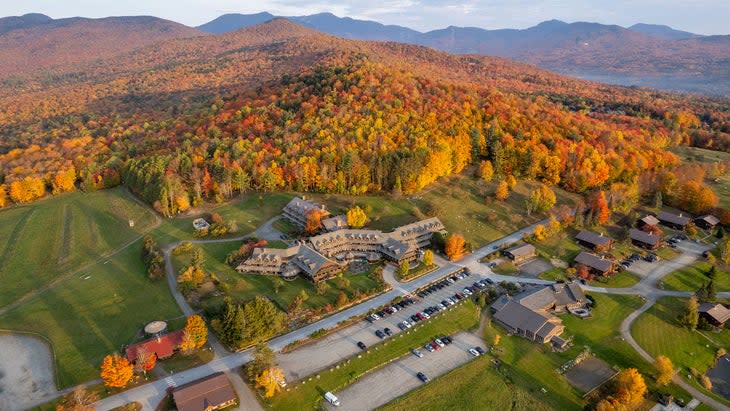
What to do in Stowe, Vermont
Hike the Mansfield Traverse: This six-mile day hike has you climbing up Stowe Mountain Resort's Haselton Trail to the top of Mansfield's Nose before zipping along the ridgeline and descending the Long Trail into Smugglers' Notch State Park. The climbing is arduous, but you earn 360-degree views of the Green Mountains in their fall splendor.
Mountain Bike Cady Hill Forest: For an easy pedal, stick to the 5.5-mile Stowe Recreation Path, a paved greenway that cruises along the West Branch of the Little River through the farm country north of town. For singletrack, veer off the Stowe Rec Path and head to Cady Hill Forest, where 11 miles of purpose-built trails flow through a canvas of technicolor leaves. The nearly mile-long descent on Florence, with its banked turns, rollers, and tabletops, is the standout trail in the forest.
Stay: There's no shortage of quality lodges and resorts in and around Stowe, but I like the vibe at Talta Lodge, designed with adventure in mind. It offers bike storage, a yoga room, and direct access to the Little River and the Stowe Rec Path. (From $150.)
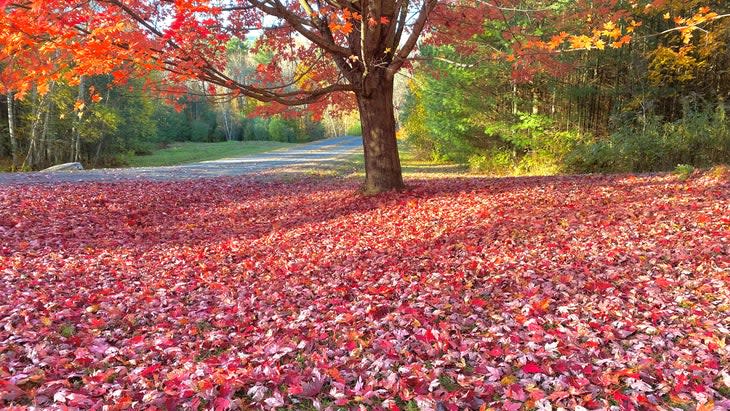
Don't Miss: The apple cider. Fall means more than just pretty leaves in Vermont. It means ripe apples. Cold Hollow, a working cider mill, has become a destination for those who want to see how cider is made while also sampling the goods. There's a restaurant on site, too; get a grilled panini with local cheddar and cider jelly.
4. Taos, New Mexico
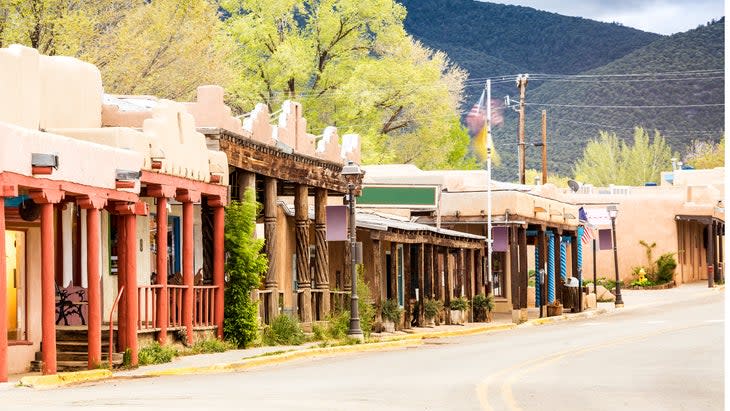
Don't let the high-desert location fool you; there are plenty of hardwoods in these hills. The Sangre de Cristo Mountains are packed with stands of aspen trees turning yellow and orange in the fall, sticking out like splotches of paint against the backdrop of evergreens. Go lower in the valley, and the cottonwoods are turning yellow. I spent a weekend fly fishing streams around Taos one fall several years ago and was blown away by the color surrounding me. Meanwhile, restaurants, such as a local favorite called the Love Apple, make the most of autumn harvests, while the Taos Valley Farmer's Market brims with apples, greens, gourds, and nuts.
Peak Season: Leaves begin to change in the middle of September, and color will peak in mid-October, lingering into November. Get your timing right and you can hit the annual Oktoberfest in nearby Red River (October 6 to 8), which is complete with German food and music.
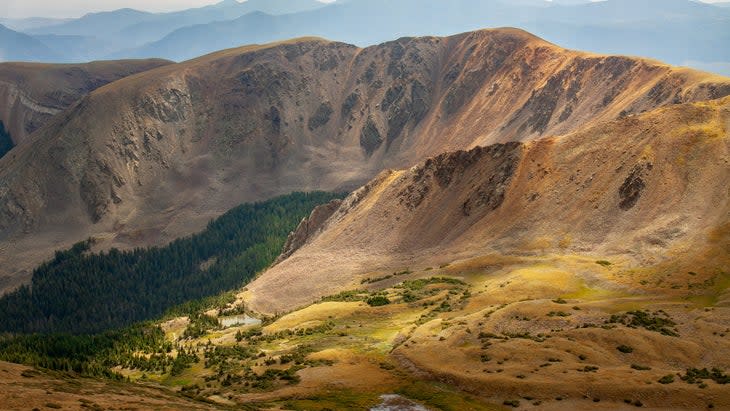
What to do in Taos, New Mexico
Raft the Rio Grande: There's some serious whitewater nearby as the Rio Grande rages through the Taos Box Canyon, but there's also serious foliage to be seen on the mellow stretches of the famous river. Sign up for a half-day float of the Orilla Verde section of the Rio Grande ($65 per adult) where the water meanders past stands of cottonwoods in full glory. Trips run into the middle of October.
Take a Scenic Drive: Highway 64, an 80-mile byway from Taos to Tierra Amarilla, features a number of pullouts overlooking the Brazos Cliffs, which are flanked by golden aspens. Also be sure to stop at Garcia Park, inside Carson National Forest, where a high-elevation meadow is ringed by aspens, and the higher peaks of Wheeler Peak Wilderness Area dominate the skyline.
Stay: Taos Goji Eco Lodge has a handful of cabins and tipis on a 40-acre farm north of Taos (from $119 for tipis; from $129 for cabins). The goji berries for which it is named are harvested in the summer, but the farm also features pumpkin patches and apple orchards, not to mention barrel saunas set beneath the hardwoods.
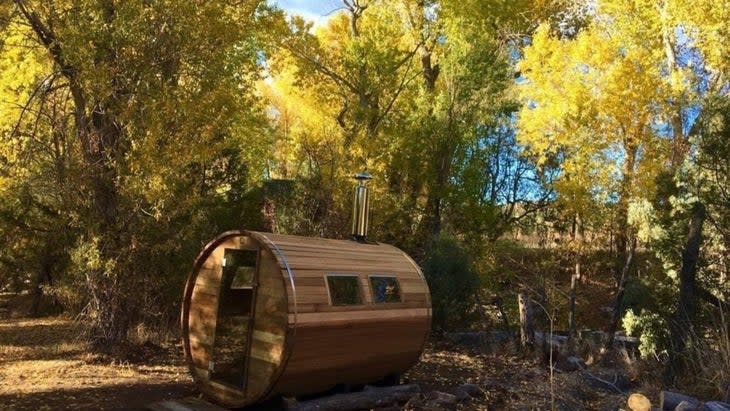
Don't Miss: Angel Fire Resort runs a scenic chairlift on weekends in the fall ($20 per adult), carrying you to the top of the 10,677-foot peak of the same name, for views of the entire Moreno Valley and Wheeler Peak beyond. From the top, you can take your pick of hiking trails down.
5. New Paltz, New York
This vibrant college town (go SUNY Hawks!) sits on the edge of the Shawangunk Ridge within the Catskill Mountains, just 90 miles from New York City. The terrain is a mix of rocky crags, steep mountains, and Hudson River farmland, most of which is shrouded in tufts of hardwoods that turn it on each fall. Much of the land surrounding this town of 7,500 is protected as either a state park or preserve and open to the public.
Peak Season: The colors tend to peak between early and mid-October, as the red oaks, maples, and dogwoods shift into bright reds, oranges, and yellows. September and October are prime apple-picking season as well. Pick your own (and pumpkins too) at Dressel Farms.
What to do in New Paltz, New York
Climb in the Gunks: The Shawangunk Ridge, aka the Gunks, is a collection of quartz conglomerate cliffs inside the Mohonk Preserve ($20 entry fee) in the Catskills Mountains that offer some of the best trad climbing in the country, with hundreds of high-quality routes, mostly one to three pitches. September and October, thanks to the cooler weather, are stellar climbing season. The scenery ain't bad either, as the hardwoods that dominate the valley below the Shawangunks are ablaze with color. Try the classic two-pitch High Exposure, an amazingly airy 5.6 with a roof crux that will have you questioning the grade.
Bike the carriage trails: Minnewaska State Park has an extensive system of double-track carriage trails that are perfect for your gravel bike. Knock out a 25-mile grand-tour loop of the system, and you'll loop around Lake Minnewaska and top out on outcroppings with dramatic views of the area.
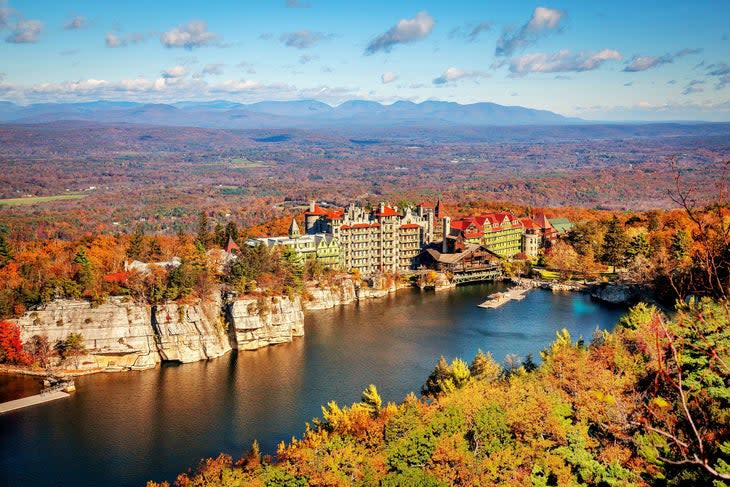
Stay: The rooms at Mohonk Mountain House aren't cheap (from $995 a night), but the massive historic building sits on its own lake and the prices are all-inclusive, including three meals, afternoon tea and cookies, and access to 85 miles of trails on the property. You can even borrow fishing rods and bait to fish in the lake.
Don't Miss: The hard cider. The Hudson Valley has a longstanding tradition of apple growing, and a number of cideries have popped up in recent years. Brooklyn Cider grows the apples on its own farm, just east of New Paltz, for its dry and semi-sour ciders. Try the raw cider, which is unfiltered and wild-fermented.
6. Leavenworth, Washington
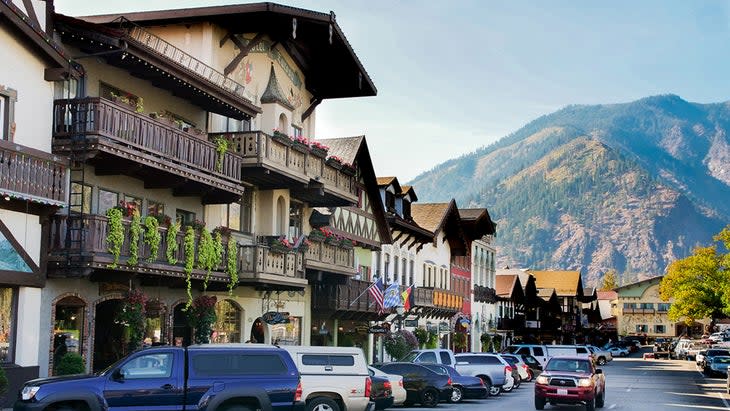
Tucked into the Cascade Mountains, the Bavarian-styled village of Leavenworth is partially known as a ski town thanks to its access to Stevens Pass, 40 minutes away. But I'd argue that Leavenworth truly comes alive in the fall, amid the glow of the aspens and cottonwoods that surround the Wenatchee River as it winds through town, while the restaurants and breweries that line Front Street double down on German fare. Bonus? The mountains surrounding Leavenworth have stands of Larch trees, pines whose needles turn golden yellow during the fall.
Peak Season: Leaves start turning in the middle of September and typically peak in mid-October. The small town hosts one of the largest Oktoberfests in the country, with events that span three weekends (September 29 to 30, October 6 to 7, and October 13 to 14).
What to do in Leavenworth, Washington
Boulder in Icicle Creek Canyon: Bouldering on the river rocks along the edge of Icicle Creek will put you in the thick of some of the best foliage in the area. Boulders with established problems can be found throughout the canyon along the road. There is no shortage of options, but head to the Forestland Boulders for the biggest selection at all grades. Breadline, a V0 with gentle layback moves and a clean landing, is the best entry problem to the area.
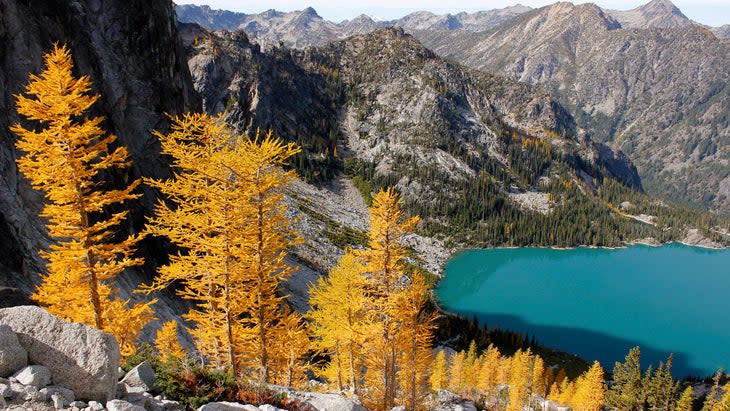
Hike to Colchuck Lake: This aqua-blue alpine lake sits beneath two of the tallest peaks in Washington: Dragontail and Colchuck Peak. It's a pretty scene any time of year, but downright magnificent in the fall when the thick forest of larches on the edge of the lake go golden. It's a tough eight-mile out and back, but one of the most brilliant foliage hikes ever. Make sure you have cash for a parking pass at Colchuck Lake Trailhead ($5 a day, or purchase an annual Northwest Forest Pass which covers all day-use fees for $30).

Stay: Bed down at LOGE Riverside, which has eight recently renovated one-bedroom cabins along the Wenatchee River. In addition to views of the river, the cabins feature a communal outdoor area with hammocks, fire pits, and an open-air kitchen. (From $143 a night.)
Don't Miss: A brat at Munchen Haus. You're in Bavaria, right? So you order a brat, put some sauerkraut and locally made mustards on it, sit in a beer garden next to a fire pit, and eat it.
7. Crested Butte, Colorado
You know Crested Butte Resort offers insanely good skiing, and you may know that downtown Crested Butte has a fun, Wild West vibe thanks to the multi-colored facades of the wooden buildings that line Elk Avenue, many of which date back to the late 1800s. But you might not know that those mountains that turn white in winter will shimmer with golden aspens in the fall. September and October are shoulder season in this ski town, which means you won't have to fight the crowds that line up for the powder come winter.
Peak Season: The aspens should peak in the middle of September and fizzle out by the first of October. Show up on September 9 for the Mount Crested Butte Chili and Beer Fest and you can sample bowls of the good stuff from amateurs and professional chefs alike.
What to do in Crested Butte, Colorado
Hike Kebler Pass: Colorado is known for its aspens, and even has a pretty famous town named after the tree. But the largest aspen grove in the state sits at Kebler Pass in Gunnison National Forest. It's more than 100 acres, holding an estimated 47,000 trees. Hike the easy Three Lakes Loop from Lost Lake Campground near the summit of the pass, for a three-mile jaunt through the yellow trees.
Bike Strand Hill: Kebler Pass has no monopoly on aspens in the Crested Butte area.
Strand Hill is an intermediate-friendly mountain-bike trail that cruises through broad meadows with epic views of Teocali and Whetstone Mountains before delivering you into thick groves of aspens. The singletrack is more flowy than technical, such that the trail stands out amid Crested Butte's notoriously gnarly mountain biking.

Stay: Scarp Ridge Lodge, in a renovated historic saloon, isn't huge; there are only six bedrooms, but it's the common spaces that make this lodge sing. The place is outfitted with an indoor saltwater pool, rooftop hot tub, steam room, and gear lockers, and it even boasts an oxygen-enriched air system to help you combat altitude fatigue. (From $1,080 a night, two-night minimum.)
Don't Miss: The rum at Montanya Distillery. Head to the tasting room in downtown Crested Butte for samples of their American-made rum and other cocktails. Order the Hot Flash, a pineapple-and-habanero-infused rum with house-made apple cider.
8. Eureka Springs, Arkansas
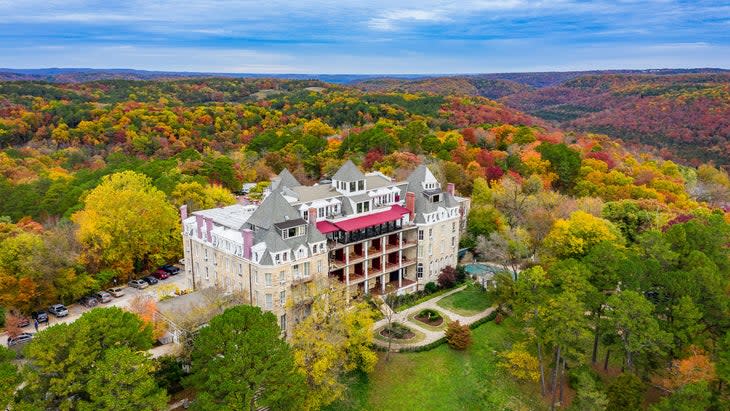
Eureka Springs is just plain pretty. The whole town, which is built into the side of a mountain, is on the National Register of Historic Places for its lovingly restored Victorian-era architecture. In the fall, those ornate buildings are completely enveloped by technicolor hardwoods. Need more enticing? The town has 13 cold natural springs, which people have been visiting for their healing properties since the late 1800s. Meanwhile, the mellow Ozark Mountains roll away from main street in every direction.
Peak Season: Mild temps and lower elevation means a later bloom, so expect the leaves to peak late in October.
What to do in Eureka Springs, Arkansas
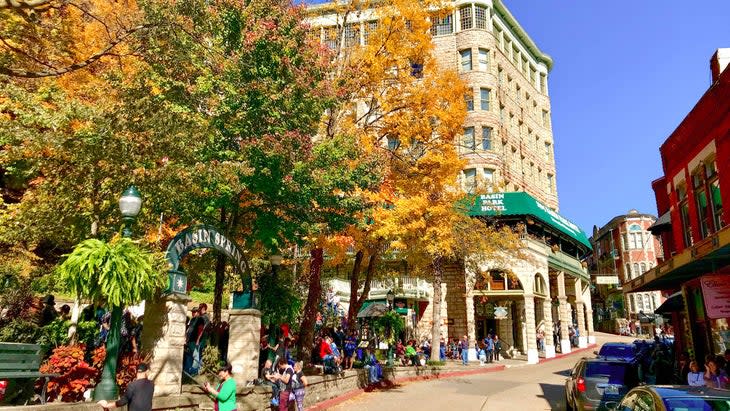
Bike Lake Leatherwood: This city park protects 1,610 acres of surprisingly steep slopes on the edge of Lake Leatherwood, which is why pro trail builders targeted the park for the Lake Leatherwood Gravity Project, a series of downhill-mountain-bike trails. The spot has now become the state's most coveted downhill park. There's something for all skill levels, but DH2, a black diamond, is the standout, beginning with lots of flow before finishing with a quarter-mile of steep, rocky bliss.
Paddle the Kings River: Kings is a free-flowing river running north through the Ozarks into Missouri, passing a series of dramatic rock bluffs and dense forest on its 90-mile journey. Canoe the mellow eight-mile Rockhouse to Trigger Gap, which passes through a preserve owned by the Arkansas Nature Conservancy, and is full of rocky beaches and flanked by foliage. Rent canoes and arrange for a shuttle with Kings River Outfitters ($80 a day).
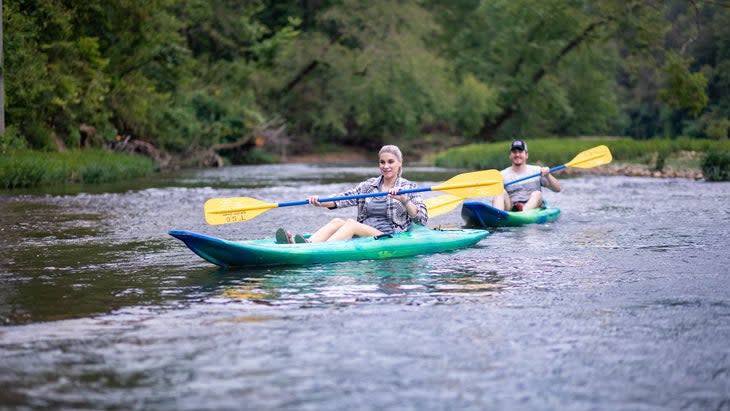
Stay: Complete your tour-de-trees by sleeping in them. The Enchanted Treehouses are six elevated cabins in a canopy of colorful leaves in a 52-acre forest. Each treehouse comes with a fireplace and hot tub. (From $249 a night.)
Don't Miss: The seasonal menu at Le Stick Nouveau. It's a set, multi-course affair that changes monthly or weekly depending on the chef's mood and what's available. Last October had fall-inspired twists like lamb-and-pumpkin pot pie and pear-and-cider sorbet.
9. Stanley, Idaho
There's "small," and then there's Stanley, with a year-round population of fewer than 75. Summer is high season in this outpost tucked into the Sawtooth Valley, at the base of the rugged Sawtooth Mountains, so fall takes on a relatively sleepy vibe. That's just fine by us, because you're here for the foliage, not the crowds. Yellow and gold cottonwoods line the rivers, and aspens decorate the mountain slopes. As for recreation, you've got fishing and hiking galore, not to mention a bevy of natural hot springs for soaking.
Peak Season: Show up in late September or early October for your best chance at peak color. Also note that a lot of businesses shut down by the end of October.
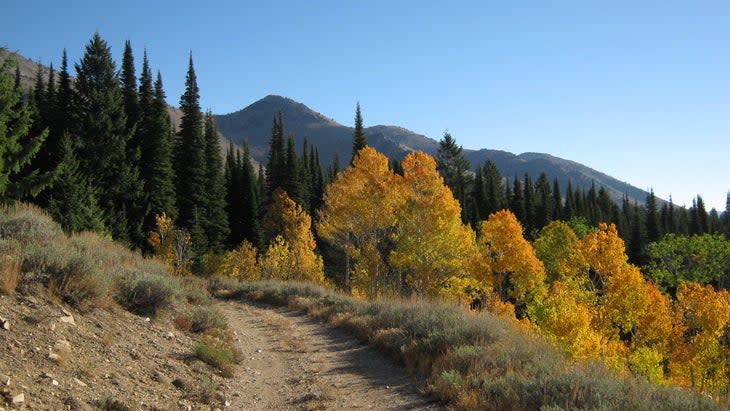
What to do in Stanley, Idaho
Bike the Sawtooths: The 116-mile Sawtooth Scenic Highway (highway 75) makes for a foliage-filled jaunt. You can take it easy in a car or earn your views by pedaling a portion of this highway. The Galena Summit Overlook (8,701 feet) at the top of Galena Pass makes for a good turnaround point, as it offers a broad view of the entire Sawtooth Valley, highlighted by the headwaters of the Salmon River and the rocky peaks of the Sawtooth Mountains. It's a big, 60-mile out and back, but you'll get your fill of foliage and scenic views.
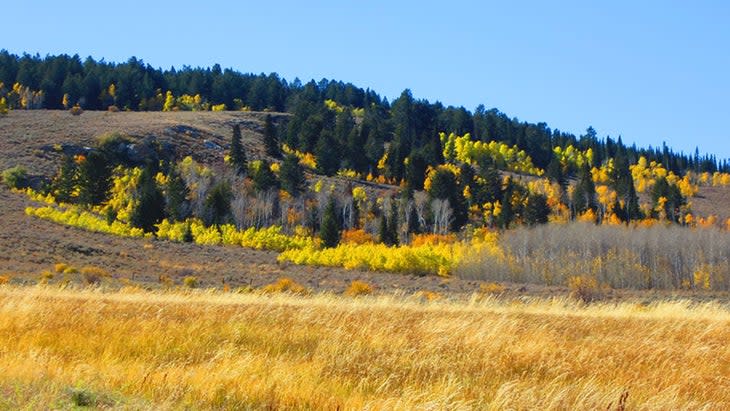
Hike the Redfish Lake Area: The 1,500-acre Redfish Lake, south of Stanley, is a hub of recreation in the Sawtooth Valley, hosting a number of trailheads with paths leading into the higher elevations of the Sawtooth Mountains. The lake is also a hot spot for fall foliage, as the banks surrounding the water are filled with aspens glinting in the sun. Hike the 4.4-mile out and back Fishhook Creek Trail (Trail 186), from the Redfish Trailhead, for an easy stroll through a tunnel of these sparkling trees.
Stay: Mountain Village Inn has inexpensive rooms in the heart of town. Those rooms also have incredible views of the Sawtooths, and access to the resort's private hot springs. (From $119.)
Don't Miss: The hot springs. There are 130 different hot springs in Idaho, several of which surround the small town of Stanley. You have many options, but Kirkham Hot Springs, with its waterfall and separate natural pools, might be the most scenic.
Graham Averill is Outside magazine's national-parks columnist. He loves all seasons, but after this incredibly hot summer, is really looking forward to fall. He's ready to ride bikes through falling leaves and drink malty lagers next to a campfire.
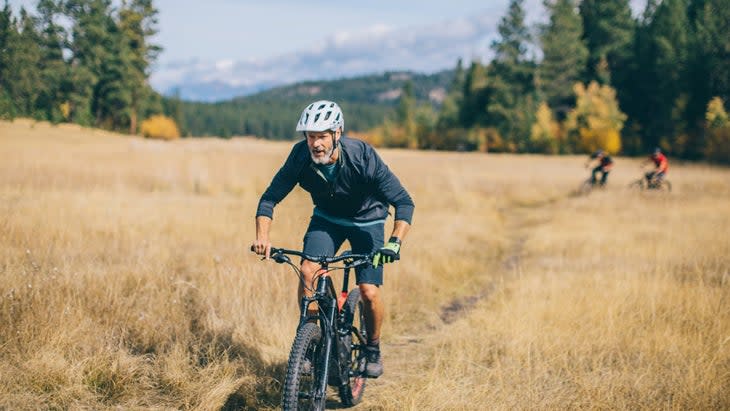
For more by this author, see:
For exclusive access to all of our fitness, gear, adventure, and travel stories, plus discounts on trips, events, and gear, sign up for Outside+ today.

